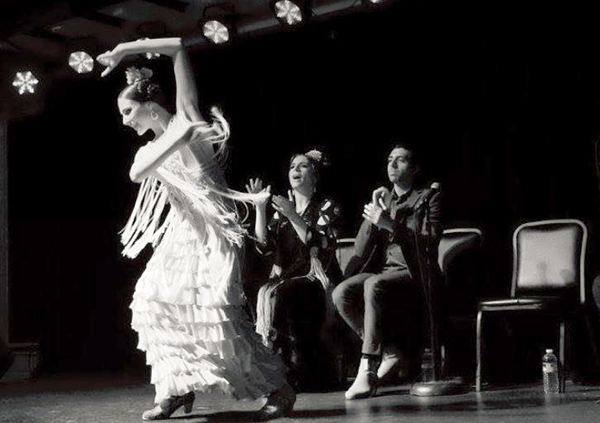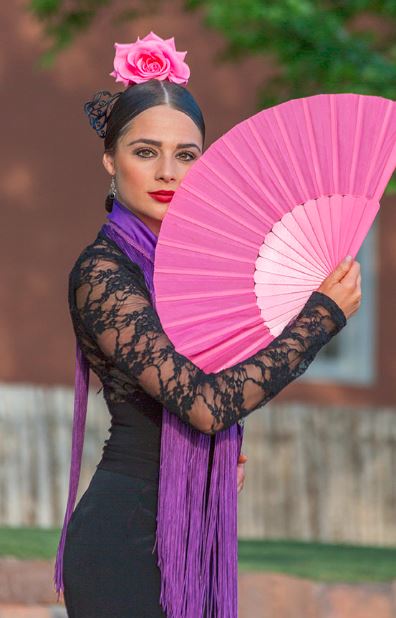The Camino of Pursuing Dance
LA EMI is a flamenco dancer in Santa Fe, New Mexico. She shares her view of flamenco as a camino, a path, rather than a destination at professionalism. Her responses are part of a larger series dissecting what it means to be a professional dancer. To read other perspectives on the topic, click here.
~~
What does your current regular dance practice look like?
My routine: I begin with floor stretches and strengthening exercises that were given to me by my physical therapist, Michael Hoerning, ARC Physical Therapy. I then go into the routine that was taught to me by my maestra, Carmela Greco. It starts with arm stretches to promote more flexibility, it pinpoints the arms, hands and feet, and concludes with full body exercises to promote body connection. Depending on the day and if I will be working on a dance with props, I warm up my castanets or run through various bata de cola exercises. I then move into whichever choreography I am working on.
Would you call yourself a professional dancer?
This is an interesting question. I am a student in this art form, but this is how I make a living. I still have a tremendous amount to learn, one day at a time.
What do you believe is necessary for a dancer to call themselves professional? Is part of being a professional getting paid?
There are many people who are aficionados of flamenco who don’t necessarily do it for a living but they have an extensive knowledge of the art form. There are other artists who use it to make a living.
Is there a certain amount of training involved in becoming a professional dancer?
Flamenco requires a tremendous amount of training and dedication. A saying from my childhood teacher, Maria Benitez: “It takes fire and passion.”
Do you consider project-based work or solo work to be professional?
Yes. Different artists have different roads in this art form.
Do you think the definition of a professional dancer is different than it was 25 or 50 years ago? If so, do you have any ideas why it might have changed?
This is a hard question for me to answer as I am 26 years old. I am sure over time, things have changed.
Are there instances when people apply the term “professional” to a dancer or group of dancers when you feel it shouldn’t be applied?
Yes. I think that to be a flamenco artist, it requires a life-long study wherein one never arrives. It is a camino… a way of life. The goal should not be to become a professional dancer, but to become a good student, a person of respect and humility.
Vice versa, are there instances when people don’t apply the term “professional” to a dancer or group of dancers when you feel it should be applied?
Today, many people can call themselves professional artists but, at the end of the day, words are a dime a dozen. What matters is what happens when they are doing the art form.
How might your cultural perspective – where you live, where you’re from, what form of dance you practice – influence what you think of as professional?
I was born and raised in Northern New Mexico, a place of very rich and beautiful culture. One of the things that draws me to flamenco is that it is an art form born of and for the people; it tells a story, your story.
What do you wish people wouldn’t assume about the dance profession?
Something that I have heard people say to me on several occasions is: “Oh, you have it so easy, you just get to dance all day.” Being a professional dancer requires a lot of dedication, discipline and perseverance.
La Emi, photographed at La Mesita Ranch, Photo © Daniel Quat Photography
~~
La Emi began studying flamenco at the age of four with the Maria Benitez Institute for Spanish Arts. In 2010, she performed in the production of “El Pintor” at the National Hispanic Cultural Center in Albuquerque. La Emi also began working with Compañia Chuscales y Mina Fajardo, where she continues to collaborate today. In Santa Fe, she has performed with Entreflamenco, the company of Antonio Granjero and Estefania Ramirez, and with the Juan Siddi Flamenco Santa Fe. Since 2013, La Emi has traveled to Spain to study intensively with Carmela Greco and other top artists including José Galván, Juana Amaya, Yolanda Heredia, Ivan Vargas Heredia, Orombo, and Rocio Alcaide Ruiz. She has performed under the direction of Carmela Greco, José Galván, and Torombo and at major venues and events including the Carmela Greco Seminario de Flamenco y Danza Española in Madrid; Cueva Los Tarantos in the Sacramonte of Granada; in Sevilla at the Teatro Alameda Festival Flamenco; and the Café de Chinitas in Madrid. Currently, she teaches at the EmiArteFlamenco Academy, as well as performs in many venues throughout New Mexico and the country.
To learn more, visit www.EmiArteFlamenco.com.


